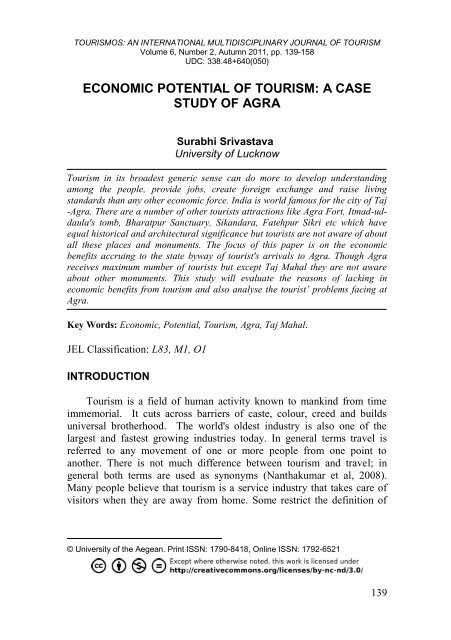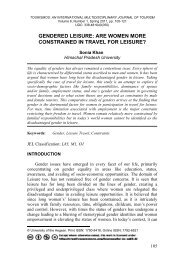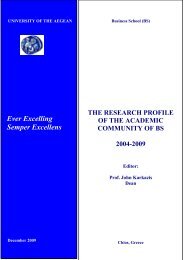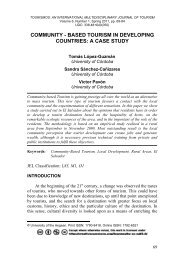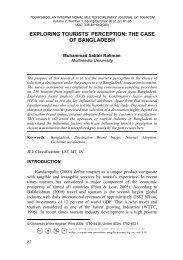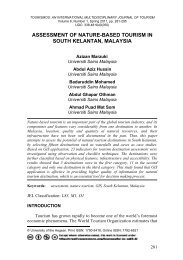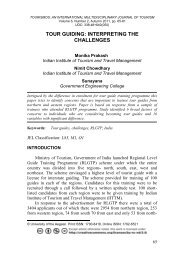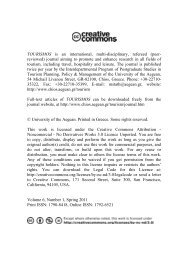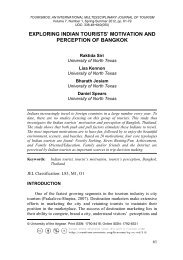ECONOMIC POTENTIAL OF TOURISM : A CASE STUDY OF AGRA
ECONOMIC POTENTIAL OF TOURISM : A CASE STUDY OF AGRA
ECONOMIC POTENTIAL OF TOURISM : A CASE STUDY OF AGRA
Create successful ePaper yourself
Turn your PDF publications into a flip-book with our unique Google optimized e-Paper software.
<strong>TOURISM</strong>OS: AN INTERNATIONAL MULTIDISCIPLINARY JOURNAL <strong>OF</strong> <strong>TOURISM</strong><br />
Volume 6, Number 2, Autumn 2011, pp. 139-158<br />
UDC: 338.48+640(050)<br />
<strong>ECONOMIC</strong> <strong>POTENTIAL</strong> <strong>OF</strong> <strong>TOURISM</strong>: A <strong>CASE</strong><br />
<strong>STUDY</strong> <strong>OF</strong> <strong>AGRA</strong><br />
Surabhi Srivastava 1<br />
University of Lucknow<br />
Tourism in its broadest generic sense can do more to develop understanding<br />
among the people, provide jobs, create foreign exchange and raise living<br />
standards than any other economic force. India is world famous for the city of Taj<br />
-Agra. There are a number of other tourists attractions like Agra Fort, Itmad-uddaula's<br />
tomb, Bharatpur Sanctuary, Sikandara, Fatehpur Sikri etc which have<br />
equal historical and architectural significance but tourists are not aware of about<br />
all these places and monuments. The focus of this paper is on the economic<br />
benefits accruing to the state byway of tourist's arrivals to Agra. Though Agra<br />
receives maximum number of tourists but except Taj Mahal they are not aware<br />
about other monuments. This study will evaluate the reasons of lacking in<br />
economic benefits from tourism and also analyse the tourist’ problems facing at<br />
Agra.<br />
Key Words: Economic, Potential, Tourism, Agra, Taj Mahal.<br />
JEL Classification: L83, M1, O1<br />
INTRODUCTION<br />
Tourism is a field of human activity known to mankind from time<br />
immemorial. It cuts across barriers of caste, colour, creed and builds<br />
universal brotherhood. The world's oldest industry is also one of the<br />
largest and fastest growing industries today. In general terms travel is<br />
referred to any movement of one or more people from one point to<br />
another. There is not much difference between tourism and travel; in<br />
general both terms are used as synonyms (Nanthakumar et al, 2008).<br />
Many people believe that tourism is a service industry that takes care of<br />
visitors when they are away from home. Some restrict the definition of<br />
© University of the Aegean. Print ISSN: 1790-8418, Online ISSN: 1792-6521<br />
139
Surabhi Srivastava<br />
tourism by number of miles away from home, overnight stays in paid<br />
accommodations, or travel for the purpose of pleasure or leisure.<br />
Others think that travel and tourism should not even be referred to as<br />
an industry. Hunt and Layne (1991) acknowledge the problems of<br />
defining travel and tourism. They say that travel was the most accepted<br />
term until 1987 and that since that time tourism is the accepted term used<br />
to “singularly describe the activity of people taking trips away from home<br />
and the industry which has developed in response to this activity”.<br />
ROLE <strong>OF</strong> <strong>TOURISM</strong> IN <strong>ECONOMIC</strong> DEVELOPMENT<br />
Tourism today is one of the fastest growing industries throughout the<br />
world. A large number of developing countries today are aware of the<br />
economic potential benefit of tourism. The economic value of tourism to<br />
an economy is measured by its contribution to the national income, the<br />
earnings of foreign exchange, its contribution to the state revenues & the<br />
creation of employment The importance of earnings for developing<br />
countries is, however, much more felt than those for developed countries.<br />
Although tourism is sensitive to the level of economic activity in the<br />
tourist generating countries, it provides more stable earnings than being<br />
provided by primary products.<br />
Tourism is thus the most important source of income for many<br />
countries. For instance, newly emerging countries in such areas as the<br />
Caribbean depend very heavily on tourist income, which often represents<br />
the major part of the gross domestic product (GDP).<br />
Tourism as a source of income is not easy to measure, at least with<br />
any degree of accuracy, the reason being of the multiplier effect (Clarke<br />
et al, 2009; Brida et al, 2010; Rastegar, 2010). The flow of money<br />
generated by tourist spending multiplies as it passes through various<br />
sections of the economy through the operation of the multiplier effect<br />
(Dritsakis, 2008; Boopen, 2006). Tourism not only creates jobs but it also<br />
encourages growth in the primary and secondary sectors of industry. This<br />
is known as the multiplier effect which in its simplest form is how many<br />
times money spent by a tourist circulates through a country's economy.<br />
India as a tourist destination has an immense attraction of its own<br />
various angles. It is a land full of mysteries with the grandeur of its<br />
untouched mountains, the majesty of its age-old monuments.<br />
140
<strong>TOURISM</strong>OS: AN INTERNATIONAL MULTIDISCIPLINARY JOURNAL <strong>OF</strong> <strong>TOURISM</strong><br />
Volume 6, Number 2, Autumn 2011, pp. 139-158<br />
UDC: 338.48+640(050)<br />
OBJECTIVES <strong>OF</strong> THE <strong>STUDY</strong><br />
This research study has been basically directed to the following<br />
objectives:<br />
1. To study the prospects the various attraction spots in and around<br />
Agra.<br />
2. To identify the area of improvement needed for tourism.<br />
3. To examine tourism as a growing industry in terms of earning<br />
revenue, foreign exchange and providing employment<br />
opportunities in Agra.<br />
In order to fulfill the objectives, few null hypothesis will be tested<br />
under this study through T Test:<br />
1. There is no significant difference between the importance<br />
accorded and the level of satisfaction experienced by tourists<br />
about hotels, lodges and apartments.<br />
2. There is no significant difference between the importance<br />
accorded and the level of satisfaction experienced by tourists<br />
about the types of hotel offering them.<br />
3. There is no significant difference between the importance<br />
accorded and the level of satisfaction experienced by tourists<br />
about the behavior/ Services of hotel staff at Agra.<br />
4. There is no significant difference between the importance<br />
accorded and the level of satisfaction experienced by tourists<br />
about information offices and communication centers.<br />
5. There is no significant difference between the importance<br />
accorded and the level of satisfaction experienced by tourists<br />
about behaviour of local guides and people.<br />
6. There is no significant difference between the importance<br />
accorded and the level of satisfaction experienced by tourists<br />
about locals/ Residents at Agra.<br />
7. There is no significant difference between the importance<br />
accorded and the level of satisfaction experienced by tourists<br />
about feeling of security.<br />
8. There is no significant difference between the importance<br />
accorded and the level of satisfaction experienced by tourists<br />
about the services rendered by travel agents at Agra.<br />
141
Surabhi Srivastava<br />
142<br />
9. There is no significant difference between the importance<br />
accorded and the level of satisfaction experienced by tourists<br />
about cultural attraction.<br />
10. There is no significant difference between the importance<br />
accorded and the level of satisfaction experienced by tourists<br />
about the various Government policies regarding tourism at<br />
Agra.<br />
RESEARCH METHODOLOGY<br />
To achieve the desired result the study was depend on tested methods<br />
of surveys and interviews of the various constituents of the tourism<br />
industry, including the tourists. Surveys had been conducted with<br />
purposefully designed questionnaires, and interview methods. Proper<br />
analysis of the government policies and the data of tourists arrivals and<br />
receipts in Agra will also help in deriving conclusions in the research.<br />
Informations were gathered from the state tourism department and the<br />
data available on the internet.<br />
In order to analyse the study and test the hypothesis, following<br />
statistical tools were used.<br />
Chi-square technique was used applied as given below and compared<br />
with the tabulated value at respective degree of freedom and the level of<br />
relationship was determined at 5 percent level of significance to test the<br />
null hypothesis.<br />
X²= Σ(fo-fe)²<br />
Fe<br />
Where fo= observed frequency in each cell<br />
Fe= expected (theoretical) frequency in each cell<br />
According to World Tourism Organisation;<br />
1. The share of India in international tourist arrivals in 2005 is<br />
.49% and the arrivals is only 3.92 million whereas the share of<br />
France is 9.4% ,USA is 6.11%.<br />
2. The share of India in international tourist receipts in 2005 is .8%<br />
and the total tourism receipts is only 5.73 million whereas the<br />
share of France is 6.2% ,USA is 12%.<br />
3. The share of Uttar Pradesh in domestic tourist visits during 2005<br />
is 24.3%.
<strong>TOURISM</strong>OS: AN INTERNATIONAL MULTIDISCIPLINARY JOURNAL <strong>OF</strong> <strong>TOURISM</strong><br />
Volume 6, Number 2, Autumn 2011, pp. 139-158<br />
UDC: 338.48+640(050)<br />
4. Foreign tourists arrivals in India in the year 2006 (till July)was<br />
2486117 and in 2005(till July) this figure was just 2183573.<br />
5. Foreign exchange earnings in India in the year 2006 (till<br />
July)was 15749.96 and in 2005(till July) this figure was just<br />
13668.75 Crore.<br />
6. On an average, per tourist foreign exchange earning in India was<br />
about 1462US$ against the estimated world average of US$ 844.<br />
Even when the average earnings per tourists are compared with<br />
those of the top world tourist generating countries or with<br />
countries in India‟s neighbourhood, it was highest in India with<br />
an exception of USA.<br />
<strong>TOURISM</strong> <strong>POTENTIAL</strong> <strong>OF</strong> <strong>AGRA</strong><br />
The city of Taj Mahal and a leading travel destination of India<br />
The city of Agra is world famous for Taj Mahal and a million of<br />
tourists from all over the world come here every year to savor the<br />
different moods of this magnificent edifice. As Agra was a seat of the<br />
Mughal rulers for many years, it also has number of historical monuments<br />
in and around the city, dating back to the 16/17 century. Emperor Akbar<br />
built Fatehpur Sikri, the beautiful city of red sandstone, near Agra.<br />
Agra has a rich historical background, which is amply evident from<br />
the numerous historical monuments in and around the city. Though the<br />
heritage of Agra City is linked with the Mughal dynasty, numerous other<br />
rulers also contributed to the rich past of this city. The city of Agra is<br />
situated on the west or right bank of the river Yammuna. It is connected<br />
by rail and road with most of the prinicipal cities of India. It is on the air<br />
route Delhi-Agra-Khajurao-Varanasi. Agra has a healthy climate though<br />
it tends to be extreme.<br />
After the establishment of the Mughal Empire Agra steadily gained<br />
in importance and soon became the city of India under Akbar and his two<br />
immediate successors.<br />
There is no other monument in the world, which can match the<br />
beauty and grandeur of the Taj Mahal. Besides Taj, there are other famous<br />
monuments like Agra Fort, Itmad-ud-daula's tomb, Bharatpur Sanctuary,<br />
Sikandara, Fatehpur Sikri etc.<br />
143
Surabhi Srivastava<br />
Monuments at Agra<br />
Taj Mahal<br />
Taj Mahal is regarded as one of the eight wonders of the world, and<br />
some Western historians have noted that its architectural beauty has never<br />
been surpassed. The Taj is the most beautiful monument built by the<br />
Mughals, the Muslim rulers of India. Taj Mahal was built by a Muslim,<br />
Emperor Shah Jahan (died 1666 C.E.) in the memory of his dear wife and<br />
queen Mumtaz Mahal at Agra, India. It is an "elegy in marble" or some<br />
say an expression of a "dream." Taj Mahal (meaning Crown Palace) is a<br />
Mausoleum that houses the grave of queen Mumtaz Mahal at the lower<br />
chamber. The grave of Shah Jahan was added to it later.<br />
Taj Mahal was constructed over a period of twenty-two years,<br />
employing twenty thousand workers. It was completed in 1648 C.E. at a<br />
cost of 32 Million Rupees. The construction documents show that its<br />
master architect was Ustad „Isa, the renowned Islamic architect of his<br />
time. The documents contain names of those employed and the inventory<br />
of construction materials and their origin. Expert craftsmen from Delhi,<br />
Qannauj, Lahore, and Multan were employed. In addition, many<br />
renowned Muslim craftsmen from Baghdad, Shiraz and Bukhara worked<br />
on many specialized tasks.<br />
The Taj stands on a raised, square platform (186 x 186 feet) with its<br />
four corners truncated, forming an unequal octagon. The architectural<br />
design uses the interlocking arabesque concept, in which each<br />
element stands on its own and perfectly integrates with the main structure.<br />
It uses the principles of self-replicating geometry and a symmetry of<br />
architectural elements.<br />
Its central dome is fifty-eight feet in diameter and rises to a height of<br />
213 feet. It is flanked by four subsidiary domed chambers. The four<br />
graceful, slender minarets are 162.5 feet each. The entire mausoleum<br />
(inside as well as outside) is decorated with inlaid design of flowers and<br />
calligraphy using precious gems such as agate and jasper. The main<br />
archways, chiseled with passages from the Holy Qur‟an and the bold<br />
scroll work of flowery pattern, give a captivating charm to its beauty. The<br />
central domed chamber and four adjoining chambers include many walls<br />
and panels of Islamic decoration.<br />
The mausoleum is a part of a vast complex comprising of a main<br />
gateway, an elaborate garden, a mosque (to the left), a guest house (to the<br />
right), and several other palatial buildings. The Taj is at the farthest end of<br />
144
<strong>TOURISM</strong>OS: AN INTERNATIONAL MULTIDISCIPLINARY JOURNAL <strong>OF</strong> <strong>TOURISM</strong><br />
Volume 6, Number 2, Autumn 2011, pp. 139-158<br />
UDC: 338.48+640(050)<br />
this complex, with the river Jamuna behind it. The large garden<br />
contains four reflecting pools dividing it at the center. Each of these four<br />
sections is further subdivided into four sections and then each into yet<br />
another four sections.<br />
Other Monuments within Taj Complex<br />
1. Rauza Saheli<br />
2. The tomb of Sirhindi Begum<br />
3. Fatehpuri Masjid<br />
4. Mumtazabad (Taj Ganj)<br />
Agra Fort<br />
Though Agra is more famous world over as the city of Taj, Agra Fort<br />
is another dimension to the city that attracts tourists in hordes. Built by<br />
Akbar in Red Sandstone when he was through with the consolidation of<br />
his power after accession to power in 1654, Agra Fort worked both as a<br />
military strategic point as well as the royal residence. Many of the palaces<br />
inside the fort were later added by next generations of Mughal Emperors<br />
like Jahangir and Shahjahan.<br />
Built by Akbar in Red Sandstone when he was through with the<br />
consolidation of his power after accession to power in 1654, Agra Fort<br />
worked both as a military strategic point as well as the royal residence.<br />
Many of the palaces inside the fort were later added by next generations<br />
of Mughal Emperors like Jahangir and Shahjahan.<br />
Most of the buildings within the Agra Fort are a mixture of different<br />
architectural styles. The assimilation of these different styles has given<br />
the buildings within the fort a distinctive look. For instance, the Jahangiri<br />
Palace built by Akbar is a good blend of Islamic (Persian) and different<br />
local Hindu styles. Other buildings either have a mixed style or conform<br />
predominantly to the Islamic style. Akbar, king at 14, began consolidating<br />
his empire and, as an assertion of his power built the fort in Agra between<br />
1565 and 1571, coeval with the construction of Humayun's tomb in Delhi.<br />
The Agra fort retains the irregular outline of the demolished mud-wall<br />
fort of the Lodis.<br />
The lofty battlements o the new fort cast its protective shadow over<br />
the far stretching mansions of court that nobles and princes built along the<br />
riverfront. The magnificent towers, bastions and ramparts and majestic<br />
145
Surabhi Srivastava<br />
gateways symbolized the confidence and power of the third Mughal<br />
emperor, Akbar.<br />
The fort is auricular in shape and its colossal double walls rise 20 m<br />
in height and measure 2.5 m in circumference. The fort is encircled by a<br />
fetid moat. The lofty battlements of the Agra fort cast its protective<br />
shadow over the far stretching mansions of nobles and princes built along<br />
the riverfront. The magnificent towers, bastions and ramparts and<br />
majestic gateways symbolized the confidence and power of the third<br />
Mughal emperor.<br />
The fort contains splendid palaces both in red sandstone and white<br />
marble built by two generations of prolific builders, Akbar and later on by<br />
Jahangir and Shahjahan. Of the nearly 500 Akbari buildings built in the<br />
Bengal and Gujarati traditions, only a few have survived, arrayed in a<br />
band on the riverfront.<br />
Buildings Inside the Fort<br />
146<br />
1. Jehangir Mahal<br />
2. Jodha Bai's Palace<br />
3. Delhi Gate<br />
4. Amar Singh Gate<br />
5. Akbari Mahal<br />
6. Shah jehani Mahal<br />
7. Khas Mahal<br />
8. Shish Mahal<br />
9. Anguri Bagh<br />
10. Muthamman Burj<br />
11. Mina Masjid<br />
12. Diwan -i-Khas<br />
13. Nagina Masjid<br />
14. Machchhi Bhawan<br />
15. Moti Masjid<br />
16. Diwan-i- am<br />
Fatehpur Sikri<br />
16 kms from the city of Agra, stands Fatehpur Sikri, Akbar‟s capital.<br />
Fatehpur Sikri was built during 1571 and 1585.<br />
Fatehpur Sikri is one of the finest examples of Mughal architectural<br />
splendour at its height. Though the city is in ruins, it is a place to visit if
<strong>TOURISM</strong>OS: AN INTERNATIONAL MULTIDISCIPLINARY JOURNAL <strong>OF</strong> <strong>TOURISM</strong><br />
Volume 6, Number 2, Autumn 2011, pp. 139-158<br />
UDC: 338.48+640(050)<br />
one comes to Agra.But in real terms Fatehpur Sikri is a place where one<br />
should spend some time. The sunset over the ruins is sight to cherish.<br />
Fatehpur Sikri is the best example of the culmination of Hindu and<br />
Muslim architecture. Fatehpur Sikri Mosque is said to be a copy of the<br />
mosque in Mecca and has designs, derived from the Persian & Hindu<br />
architecture.<br />
The Main Attractions<br />
Diwani-i-Am<br />
Diwani-i-Khas<br />
Jodhabai‟s Palace<br />
Friday Mosque<br />
Salim Chisti‟s Mausoleum<br />
Sikandara<br />
This monument is only 13 km. from the Agra Fort. Akbar who ruled<br />
over the Mughal Empire from 1556 to 1605, began building his<br />
mausoleum in the spartan style of Timurid architecture. The<br />
mausoleum was completed by his son, the next Mughal Emperor,<br />
Jahangir, who added more decorative elements to the design of Akbar's<br />
tomb in Sikandra.<br />
The entrance to Akbar's tomb in Sikandra is under a huge arched<br />
gateway, similar to the Buland Darwaza at Fatehpur Sikri. There are<br />
beautiful calligraphic inscriptions on the white marble front of the gate.<br />
As you enter the gate you will see a formal garden in the charbagh<br />
tradition, and the tomb of Akbar situated at the center. Within the same<br />
complex is another sober tomb made of red sandstone, which contains the<br />
grave of Akbar's wife Mariam, the mother of Jahangir.<br />
Akbar's tomb in Sikandra is built in a pyramidal shape, with an open<br />
terrace covered with carved latticework screens. The actual grave is in the<br />
basement and is decorated with paintings in colorful golden, green and<br />
blue hues on the stucco walls.The last resting place of the Mughal<br />
emperor Akbar was this city. Akbar was the greatest of the Mughal<br />
emperors and one of the most secular minded royalties of his time. He<br />
was the heir to a long tradition of oriental refinement, a great patron of the<br />
arts, literature, philosophy and science.<br />
Itmad-ud-Daula is the tomb of Mirza Ghiyas Beg, a Persian who<br />
had obtained service in Akbar's court. The tomb set a startling precedent<br />
as the first Mughal building to be face with white inlaid marble and<br />
147
Surabhi Srivastava<br />
contrasting stones. Unlike the Taj it is small, intimate and, since it is less<br />
frequented, has a gentle serenity.<br />
Chini Ka Rauza is One of the lesser-known monuments of Agra is<br />
the tomb known as the Chini ka Rauza, which is situated 1 Kilometer<br />
north of Itimad ud Daulah's Tomb. The Chini ka Rauza was built in 1635<br />
and is the tomb of Allama Afzal Khan Mullah of Shiraz, a scholar and<br />
poet who was the Prime Minister of the Mughal Emperor Shah Jahan. The<br />
tomb gets its name from the colorful tiles (chini) that cover the walls of<br />
the tomb. The tomb is built in a rectangular shape and is topped with a<br />
bulbous dome.<br />
The Soami Bagh Samadh is the mausoleum of Huzur Soamiji<br />
Maharaj (Shri Shiv Dayal Singh) in the Dayalbagh section in the outskirts<br />
of the city. He was the founder of the Radhasoami Faith and the Samadh<br />
is sacred to its followers. Construction began in 1908, and it is believed<br />
that construction will never end. It is often seen as the "next Taj Mahal".<br />
The carvings in stone, using a combination or coloured marble, is life-like<br />
and not seen anywhere else in India. When completed, the samadh will<br />
have a carved dome and a gateway<br />
Other Monuments of Agra<br />
148<br />
1. Kanch Mahal (Glass Palace)<br />
2. Tomb of Itibar Khan<br />
3. Guru -ka-Tal<br />
4. Sarai Nur Jehan<br />
5. Humayun 's Mosque Kachhpura<br />
6. Tomb of Sadiq Khan Mir-Bakhshi<br />
7. Tomb of Salabat Khan Mir-Bakhshi 'Roshan-Zamir'<br />
8. Battis Khambah<br />
9. Jami Masjid and the Muthamman Chowk<br />
10. Chhatri Rani Hada<br />
11. Tomb of Firuz Khan Khwaja Sara<br />
12. Hessing 's Tomb<br />
<strong>TOURISM</strong> CONTRIBUTORS TO ECONOMIES <strong>OF</strong> <strong>AGRA</strong><br />
The term 'Tourism contributors to economies' denotes all the service<br />
industries, which are essential for the domestic and the international<br />
tourists. It includes all the transport facilities like airlines, railways, travel<br />
buses, taxies, Accommodation sectors- all star hotels, resorts, small
<strong>TOURISM</strong>OS: AN INTERNATIONAL MULTIDISCIPLINARY JOURNAL <strong>OF</strong> <strong>TOURISM</strong><br />
Volume 6, Number 2, Autumn 2011, pp. 139-158<br />
UDC: 338.48+640(050)<br />
restaurants, local shops, different handicrafts exhibitions and other local<br />
made products.<br />
Accommodation Industry<br />
The city saw an occupancy and average rate grow in 2003-04 after a<br />
steady decline in the three previous years. The occupancy increased by<br />
5.4% and the average rate increased by 74.4%. Increased response to the<br />
survey from five-star deluxe and five-star hotels has resulted in a strong<br />
increase in average rates. (Source: www.hvsinternational.com)<br />
Transport Industry<br />
Being on the regular tourist route, which runs from Delhi-Agra-<br />
Khajuraho-Varanasi, Agra is connected by regular flights to these places.<br />
The local airport is known as the Kheria Airport. Express bus services<br />
(a/c and non-a/c) are available from Delhi, Jaipur, Lucknow, Gwalior, and<br />
Jhansi. The Rajdhani and Shatabdi trains have also their stoppage in Agra.<br />
The city is well connected by trains to almost every corner of the nation.<br />
Souvenir Industry<br />
Agra is an important center of the leather industry in India. Agra is a<br />
leading center of the footwear industry, with more than 400,000 thousand<br />
pairs of shoes being produced every day in both modern factories and<br />
cottage enterprises.<br />
Being a hub of Leather industry, Agra also offers a plethora of<br />
Leather products such as sandals, purse, wallets, jackets, trousers, skirts<br />
and more to take back home. Agra is also internationally known Rug and<br />
Carpet Weaving Industry The main markets for shopping for leather in<br />
Agra are near the Taj Mahal complex. These areas include Sadar Bazaar,<br />
Kinari Bazaar and Munro Road. The U.P State Emporium called Gangotri<br />
at the Taj Mahal Complex, offers a range of leather handicrafts. The<br />
Shilpagram crafts village is another venue where leather items are on sale,<br />
directly by the craftsmen themselves.<br />
Agra is renowned for its marble tabletops, vases and trays, inlaid with<br />
semi-precious stones in ornate floral designs, in imitation of those found<br />
in the Taj Mahal. It is also an excellent place to buy leather : Agra's shoe<br />
industry supplies all India, and its tanneries export bags, briefcases and<br />
jackets. Carpets and dhurries are manufactured here too, and traditional<br />
149
Surabhi Srivastava<br />
embroidery continues to thrive. Zari and zardozi are brightly coloured, the<br />
latter building up three-dimensional patterns with fantastic motifs; chikan<br />
uses more delicate overlay techniques.<br />
<strong>ECONOMIC</strong> IMPACT <strong>OF</strong> <strong>TOURISM</strong> AT <strong>AGRA</strong><br />
True benefits of tourism can only be appreciated on a broad basis,<br />
which include not only economic aspects but also social and cultural<br />
aspects. The impacts made by tourism depend upon the volume and<br />
profile characteristic of the tourists (their length of stay, activity, mode of<br />
transport, travel arrangements, etc.). There may be negative effects,<br />
environmental and ecological effects, etc. Tourism can play a vital role<br />
for international understanding and keeping peace in the world by<br />
developing social, cultural, economic as well as political understanding<br />
among the people of different nations and by way bringing diverse people<br />
face to face. Thus in the modern day world which is characterized by<br />
strikes, problems and misunderstanding, tourism can bring people<br />
together and promote harmony and understanding.<br />
Tourism ahs been recognized as a significant factor in the<br />
economy of many nations. It is the biggest foreign exchange earner for<br />
countries like India, Thailand, Spain. The net income generated in a<br />
country by tourism will vary directly with the expenditure of visitors in<br />
the host country and on the other side an increase in expenditure on<br />
tourism abroad by the nationals of a country lowers the national income.<br />
Tourism has been identified not only as an important source of<br />
foreign exchange earning but also as an industry creating employment<br />
opportunities and generating economic growth of the country. So proper<br />
cultivation of tourism is expected to contribute in forging links of mutual<br />
understanding and appreciation for better world of tomorrow.( Ananda<br />
Bajracharya, 1955)<br />
150<br />
Economic impact = Number of Visitors * Average spending per<br />
visitor * Multiplier<br />
This simple model is usually elaborated further by:<br />
(Dividing visitors into distinct segments with different spending<br />
patterns (e.g. campers, day users, visitors in motels).<br />
Measuring spending in distinct spending categories (e.g. lodging,<br />
restaurant meals, gas, groceries).<br />
Allocating spending into the economic sectors that receive it and<br />
applying economic ratios and multipliers for those sectors.
<strong>TOURISM</strong>OS: AN INTERNATIONAL MULTIDISCIPLINARY JOURNAL <strong>OF</strong> <strong>TOURISM</strong><br />
Volume 6, Number 2, Autumn 2011, pp. 139-158<br />
UDC: 338.48+640(050)<br />
Economic Impact of Tourism in India, Uttar Pradesh and at<br />
Agra<br />
1. Through tourism, India earns 25172 crores. foreign exchange<br />
and Uttar Pradesh alone earns foreign exchange earns 5034.45<br />
crores in the year 2005.<br />
2. The total revenue generation, from the domestic tourists and<br />
international tourists in U.P.is 7510.60 crores in 2004 from<br />
2748.67 crores in 1995.<br />
3. Total revenue from tourism in U.P. is 1129.88 lakhs in 2004-05<br />
and the total expenditure is 1107.88 lakhs in the same year. The<br />
net loss incurred by the U.P. government by the U.P. government<br />
is Rs. 53 lakhs.<br />
4. On an average, foreign tourist‟s expenditure is 6421.42in India<br />
and428.82 in Uttar Pradesh in 2005 which was 3976.41in India<br />
and 260.028 at Uttar Pradesh in 1995.<br />
5. In India, the total employment from tourism is 24,457 in 2004<br />
which reaches from 16,092in 1990.<br />
6. In India, the direct employment from tourism is 11404 in 2004<br />
which was 6820 in 1990 whereas in U.P. then there were 13861<br />
people were employed in tourism sector in the year 04-05.<br />
7. According to the survey, in India, social travel is most popular<br />
among domestic tourists 58.9% people travel for the social<br />
reasons, 13.6% travellers are religious and only 6% people<br />
travels for leisure purposes.<br />
8. According to the survey, Tirupati is the most popular destination<br />
in India. After this Puri, Vaishnodevi, Darjeeling and then Agra<br />
comes under the popular destination list. Only 1.8 million/ year a<br />
domestic tourist travels in Agra as compared to Tirupati where<br />
11.8 million tourists visits.<br />
9. According to U.P. tourism department the average stay of<br />
foreign tourists in UP is 6 days and the average stay of domestic<br />
tourists in UP is 1.2 to 1.4 days.<br />
PRESENTATION AND EVALUATION <strong>OF</strong> DATA ON <strong>ECONOMIC</strong><br />
IMPACT <strong>OF</strong> <strong>TOURISM</strong><br />
In order to complete the study, both the primary and secondary data<br />
has been taken into account. In many places, secondary data have been<br />
compiled. The work has identified with one dependent variable; Tourist<br />
151
Surabhi Srivastava<br />
Arrival in Agra with the six independent variables; world tourist flow,<br />
tourist flow to India, tourist flow to Uttar Pradesh, tourist flow to Agra,<br />
promotional expenses made by Uttar Pradesh Government.<br />
Similarly the study has attempted to identify and assess the<br />
importance and level of significance using the independent variables like<br />
tourist arrivals, season or weather, scenery, feeling of secure, behaviour of<br />
local guides, transportation, hotels, lodges and apartments, food and<br />
drinks available, tourist information offices and communication centers,<br />
shopping facilities and money exchange service at Agra.<br />
The hypothesis about the significant relation between the dependent<br />
variables like revenue generation, foreign exchange earnings with each of<br />
the independent variables has been tested by using suitable test.<br />
To find out the specific trends of domestic tourists at Agra, an<br />
extensive survey is conducted, comprising of 100 domestic tourists at<br />
different locations in Agra between the time period of September 2008-<br />
Febuary 2009. The questionnaire is prepared comprised of 30 questions<br />
which reveals their basic ideas, knowledge and experience. For foreign<br />
visitors at Agra, survey has been done, comprising of 45 tourists at<br />
different locations in Agra between the time period of September 2008-<br />
Febuary 2009. The questionnaire is prepared comprised of 30 questions<br />
which reveals their basic ideas, knowledge and experience about Agra<br />
visit.<br />
SUMMARY RESULT <strong>OF</strong> TEST <strong>OF</strong> HYPOTHESIS:<br />
Indian tourists<br />
152<br />
Hypothesis<br />
No.<br />
Description<br />
“Variation<br />
between IA<br />
and LOS as<br />
EBT<br />
about….”<br />
1 Lodging<br />
facility<br />
2 Types of<br />
hotel<br />
3 Behaviour/<br />
services<br />
provided by<br />
the<br />
staff<br />
hotel<br />
Test<br />
Applied<br />
X² value at 5%<br />
level of<br />
significance(LOS)<br />
Tabulated Value=<br />
7.815<br />
Result<br />
Variation<br />
X² test CV=19.52 Significant<br />
X² test CV=41.12 Significant<br />
X² test CV=90.8 Significant
<strong>TOURISM</strong>OS: AN INTERNATIONAL MULTIDISCIPLINARY JOURNAL <strong>OF</strong> <strong>TOURISM</strong><br />
Volume 6, Number 2, Autumn 2011, pp. 139-158<br />
UDC: 338.48+640(050)<br />
4 Information<br />
Offices<br />
5 Behaviour<br />
of Local<br />
guides<br />
6 Behaviour<br />
of localites<br />
7 Feeling of<br />
security<br />
8 Services by<br />
travel<br />
agents<br />
9 Cultural<br />
Activities<br />
10 Government<br />
Policies<br />
X² test CV=54.56 Significant<br />
X² test CV=23.52 Significant<br />
X² test CV=46.24 Significant<br />
X² test CV=29.26 Significant<br />
X² test CV=39.68 Significant<br />
X² test CV=46.24 Significant<br />
X² test CV=19.36 Significant<br />
International Tourists<br />
Hypothesi<br />
s No.<br />
Descriptio<br />
n<br />
“Variation<br />
between<br />
IA and<br />
LOS as<br />
EBT<br />
about….”<br />
1 Lodging<br />
facility<br />
2 Types of<br />
hotel<br />
3 Behaviour/<br />
services<br />
provided<br />
by the hotel<br />
staff<br />
4 Information<br />
Offices<br />
5 Behaviour<br />
of Local<br />
guides<br />
6 Behaviour<br />
of localites<br />
Test<br />
Applie<br />
d<br />
X² value at 5%<br />
level of<br />
significance(LOS<br />
) Tabulated<br />
Value= 7.815<br />
Result<br />
Variation<br />
X² test CV=9.74 Significant<br />
X² test CV=8.94 Significant<br />
X² test CV=3.89 Insignifican<br />
t<br />
X² test CV=4.07 Insignifican<br />
t<br />
X² test CV=12.14 Significant<br />
X² test CV=12.14 Significant<br />
153
Surabhi Srivastava<br />
7 Feeling of<br />
security<br />
8 Services by<br />
travel<br />
agents<br />
9 Cultural<br />
Activities<br />
X² test CV=8.14 Significant<br />
X² test CV=31.61 Significant<br />
X² test CV=2.54 Insignifican<br />
t<br />
SUGGESTIONS<br />
Economically, the solicitation by the Taj from Agra has a strong<br />
potential invitation for the tourists and for the development of tourism as<br />
an industry by the competent authorities.<br />
In order to encounter the above general problems in tourism industry<br />
at Agra, the following remedial steps may effectively bring improvements<br />
to secure high degree of positive results.<br />
Facility of providing the services of an airport of international level,<br />
so that the air tourists may drop at this airport and reach their destination<br />
point at Agra without wasting their time instead of dropping at Delhi<br />
airport and reach Agra by road journey.<br />
Merely viewing the magnificence of monumental architectural<br />
structures shall not bind the tourists for their longer stay at Agra. To<br />
encounter any shortcoming, some newly challenging and attractive points/<br />
place etc. should be developed which oblige the tourist to come to Agra<br />
and induce their haltage at Agra for a sufficiently longer period span.<br />
This will nullify their intention of short stay to Agra to visit Taj only and<br />
thereafter more either to Jaipur or back to Delhi or any other place for<br />
better comfortable lodging facilities or so on.<br />
The examples of establishing developing and promoting the science<br />
city at Kolkata, Hawa Mahal at jaipur,Vrindavan garden at Mysore, Zoo<br />
and museum of Tiruvanantpuram with rich heritages etc. may looked into<br />
case study, which shall provide a prudent guidance for exploring some<br />
suitable projects for Agra which may be ingenious for inviting more and<br />
more tourists at Agra with their longer stay here at that shall generate<br />
wider fields for economic activities at Agra.<br />
More efforts should be endeavored to popularize densely the dignity<br />
of all other old monuments at Agra. It will generate more employment,<br />
infrastructure and social and financial upliftment of Agrites directly.<br />
154
<strong>TOURISM</strong>OS: AN INTERNATIONAL MULTIDISCIPLINARY JOURNAL <strong>OF</strong> <strong>TOURISM</strong><br />
Volume 6, Number 2, Autumn 2011, pp. 139-158<br />
UDC: 338.48+640(050)<br />
More number of budget hotels with better amenities along with well<br />
trained and well cultured guides should be made available to the tourists<br />
folks all along 24 hours services in a descent and a respectable ways.<br />
Some drive should be organized launched on regularly among the<br />
Agrites which may develop and win the confidence of the tourists which<br />
will give rise to feelings of fraternity visa versa tourists. This will create<br />
congenial atmosphere and the tourists will feel homely while away from<br />
their home. A bondage of human relationship will be established which<br />
will lead to social harmony developing better economic and status<br />
bringing better prosperity to Agrites.<br />
Some arrangements should be made to develop Agra, as a meeting or<br />
a conference center for beaurocrates and for businessmen. So that people<br />
from different part of the country and even outside country visits for the<br />
purpose of meetings, seminars, conferences and stays for two or three<br />
days. By developing this phenomenon tourists will come directly Agra<br />
and not any other city like Delhi and so on.<br />
In present days, the tourist expects something more thrilling,<br />
adventurous, knowledgeable and memorable which Agra as a tourist spot<br />
does not cater fully.<br />
The auditorium should be there at Agra where in the different culture,<br />
Art and music etc. Of Uttar Pradesh-Purvanchal, Awadh, Bundelkhand,<br />
Brij etc. can be exhibited and shown through sound and light show.<br />
Besides, there may be stalls having articles of common use and interest<br />
and the speciality of different regions of the state. Such as Muglai Kabab<br />
and chicken works of Lucknow, Balmithai of Nainital, Petha and<br />
Dalmoth of Agra, pan of Mahoba, peras of Mathura etc. be displayed<br />
there. It will no doubt attract people in good number.<br />
There is a huge difference between the western countries and India<br />
when it comes to medical costs. It has been suggested that the government<br />
should develop Agra for the health tourism. People may visit for the<br />
health reasons and relax there under the shadow of beautiful and<br />
enchanting monuments. Cottages like wards may be built where people<br />
may like to reside and relax.<br />
To achieve such a goal, a comprehensive, far sighted planning and<br />
sincere perennial efforts is needed which may explore suitable projects<br />
that may nullify the short comings of transforming Agra as an ideal<br />
tourist place.<br />
155
Surabhi Srivastava<br />
REFERENCES<br />
Government Publications<br />
Brida, J.G., Barquet, A. & Risso, W.A. (2010). Causality between economic<br />
growth and tourism expansion: Empirical evidence from Trentino-Alto<br />
adige. Tourismos, Vol. 5, No.2, pp.87-98.<br />
Rastegar, H. (2010). Tourism development and residents' attitude: A case study of<br />
Yazd, Iran. Tourismos, Vol. 5, No.2, pp.203-211.<br />
Clarke, A., Raffay, Á. & Wiltshier, P. (2009). Losing it: Knowledge management<br />
in tourism development projects. Tourismos, Vol. 4, No.3, pp.149-166.<br />
Nanthakumar, L., Ibrahim, Y. & Harun, M. (2008). Tourism development policy,<br />
strategic alliances and impact of consumer price index on tourist arrivals:<br />
The case of Malaysia. Tourismos, Vol. 3, No.1, pp.83-98.<br />
Dritsakis, N. (2008). Seasonal analysis of tourist revenues: An empirical research<br />
for Greece. Tourismos, Vol. 3, No.2, pp.57-70.<br />
Boopen, S. (2006). Transport capital as a determinant of tourism development: A<br />
time series approach. Tourismos, Vol. 1, No.1, pp.55-73.<br />
Tourism Statistics. (2005).<br />
Tourists Statistics (2006).<br />
Tourism Satellite Accounting (2005).<br />
Tourism Department Uttar Pradesh. (2001-2002). ke karya kalap publication:<br />
Tourism Department; Lucknow (Uttar Pradesh).<br />
Tourism Department Uttar Pradesh. (2002-2003). ke karya kalap publication:<br />
Tourism Department; Lucknow (Uttar Pradesh).<br />
Tourism Department Uttar Pradesh. (2003-2004). ke karya kalap publication:<br />
Tourism Department; Lucknow (Uttar Pradesh).<br />
Tourism Department Uttar Pradesh. (2004-2005). ke karya kalap publication:<br />
Tourism Department; Lucknow (Uttar Pradesh).<br />
Tourism Policy. (1995). Delhi, India, Published Tourism Department.<br />
Tourism Policy. (2001). Delhi, India, Published Tourism Department.<br />
Tourism Policy. (1995). Lucknow, Uttar Pradesh, Published Tourism Department.<br />
Tourism Policy. (1995). Lucknow, Uttar Pradesh, Published Tourism<br />
Department..<br />
Karya Purti digdarshak, aaya vyaya. (2001-01). Lucknow, Tourism Department<br />
Publication.<br />
Karya Purti digdarshak, aaya vyaya. (2001-02). Lucknow, Tourism Department<br />
Publication.<br />
Karya Purti digdarshak, aaya vyaya. (2002-03). Lucknow, Tourism Department<br />
Publication.<br />
Karya Purti digdarshak, aaya vyaya. (2003-04). Lucknow, Tourism Department<br />
Publication.<br />
Karya Purti digdarshak, aaya vyaya. (2004-05). Lucknow, Tourism Department<br />
Publication.<br />
156
<strong>TOURISM</strong>OS: AN INTERNATIONAL MULTIDISCIPLINARY JOURNAL <strong>OF</strong> <strong>TOURISM</strong><br />
Volume 6, Number 2, Autumn 2011, pp. 139-158<br />
UDC: 338.48+640(050)<br />
Karya Purti digdarshak, aaya vyaya. (2005-06). Lucknow, Tourism Department<br />
Publication.<br />
10 th V Year Plan. (2002-07). Delhi India, Tourism Department Publication.<br />
10 th V Year Plan. (2002-07). Uttar Pradesh, Tourism Department Publication.<br />
Lucknow.<br />
Tourism Statistics. (2002-03). New Delhi, Market Research Division, Tourism<br />
Department.<br />
Tourism Statistics. (2003-04). New Delhi, Market Research Division, Tourism<br />
Department.<br />
Tourism Statistics. (2004-05). New Delhi, Market Research Division, Tourism<br />
Department.<br />
Tourism Statistics. (2004-05). Gomti Nagar, Lucknow, Market Research Division,<br />
Tourism Department.<br />
Incredible India. (August, 2006). Designed for the Market Research Division,<br />
Ministry of Tourism, Government of India, New Delhi.<br />
World Tourism Organisation, Year Book of Tourism Statistics.<br />
Private Publications<br />
Bhatia, A.K. Tourism in India – History and development. New Delhi, Sterling,<br />
pp.202-225.<br />
Bose, B. Delhi Agra & Jaipur Tourism. Roli Books Pvt Ltd, pp.120-135.<br />
Ryan, C. (2003). Recreational Tourism: Demand and Impacts. Channel View<br />
Publications, pp.149.<br />
Egan, D.J. & Nield, K. The Economic Impact of Tourism-a critical review.<br />
Journal of Hospitality and Tourism Management.<br />
Glaesser, D. (2006). Crisis Management in the Tourism Industry, pp.132.<br />
Roy, C.K. & Tisdell, A.C. Tourism in India and India's Economic Development.<br />
Nova Science Publishers (August 1998), pp.48-62.<br />
Sinclair, M.T. & Stabler, M. The Economics of Tourism. Routledge, pp.166-178.<br />
Anand, M.M. Tourism and Hotel industry in India. Prints Hall of India, pp.28-32.<br />
Pittman, M. The Economics of Travel and Tourism. A. Bull Publication.<br />
Sharpley, R. & Telfer, J.D. Tourism and Development: Concepts and Issues.<br />
Channel View Publications, pp.156-168.<br />
Tej Vir Singh. (1975). Tourism and tourism industry. New Delhi, New Heights,<br />
pp.78-82.<br />
Edensor, T. (1998). Tourists at the Taj (International Library of Sociology)<br />
(Paperback), 1 st edition. Routledge.<br />
SUBMITTED: APR 2010<br />
REVISION SUBMITTED: AUG 2010<br />
2nd REVISION SUBMITTED: OCT 2010<br />
ACCEPTED: NOV 2010<br />
157
Surabhi Srivastava<br />
REFEREED ANONYMOUSLY<br />
Surabhi Srivastava (surabhi3k@gmail.com) is Lecturer at the Sherwood<br />
College of Professional Management, University of Lucknow, Lucknow,<br />
India.<br />
158


